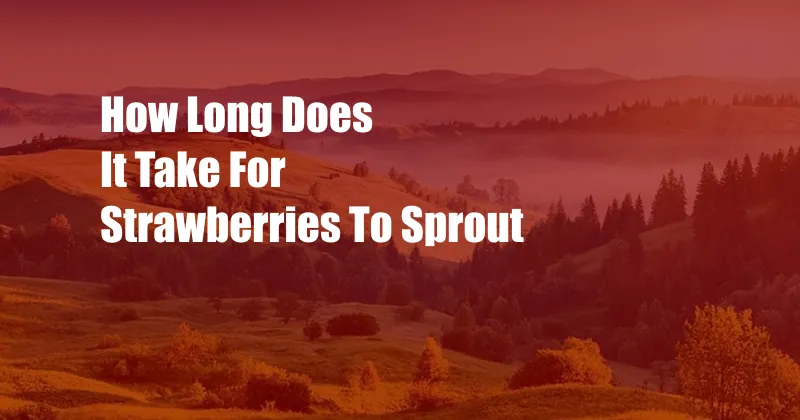
How Long Do Strawberries Take to Sprout? A Detailed Guide
As an avid gardener with a passion for nurturing the wonders of nature, the arrival of spring always fills me with an irresistible urge to sow the seeds of new life. Among the myriad of horticultural delights that beckon during this season of renewal, strawberries hold a special place in my heart. Their delicate blossoms and tantalizingly sweet fruits never fail to evoke a sense of joy and contentment.
In anticipation of summer’s bounty, I embark on the exciting journey of propagating these beloved berries from seed. However, I can’t help but wonder, how long will it be before I witness the first signs of germination? This question marks the beginning of a thrilling adventure, one that will lead me to explore the fascinating world of strawberry cultivation.
Strawberry Seed Germination: A Journey of Patience and Observation
The journey of strawberry germination is a delicate balance between providing the necessary conditions for growth and exercising patience. While the exact timeline can vary depending on factors such as temperature, light, and soil moisture, understanding the general process can help us optimize our efforts for successful sprouting.
After sowing strawberry seeds in moist, well-draining soil, they embark on a period of dormancy. During this time, the seeds absorb moisture and begin to swell, preparing for the momentous event of germination. As days turn into weeks, the first signs of life emerge.
Breaking the Seed Coat: A Critical Milestone
The most visible indicator of germination is the emergence of a tiny, white radicle, or primary root, from the seed coat. This delicate structure is responsible for anchoring the developing seedling in the soil and absorbing essential nutrients. Once the radicle has emerged, the seed coat splits open, allowing the first true leaves, known as cotyledons, to unfurl.
The cotyledons, often heart-shaped in strawberries, serve as the initial source of nourishment for the seedling. They contain stored energy reserves that fuel its growth until true leaves develop and begin photosynthesis. As the seedling matures, the cotyledons gradually wither away, while the true leaves continue to expand and develop.
Optimizing Conditions for Successful Germination
To maximize the chances of successful strawberry germination, it is essential to provide optimal growing conditions. Ideal temperatures range from 60 to 70 degrees Fahrenheit, with ample sunlight or artificial lighting. The soil should be moist but not waterlogged, as excessive moisture can inhibit germination and promote fungal growth.
Well-draining soil is crucial to prevent waterlogging. A mixture of peat moss, vermiculite, and perlite creates an airy, porous medium that allows excess water to drain away while retaining sufficient moisture for the seeds. Maintaining consistent moisture levels is vital, as fluctuations can interfere with germination.
Tips and Expert Advice for Budding Strawberry Growers
Drawing upon my experience and insights gleaned from reputable sources, I offer the following tips to enhance your strawberry seed germination endeavors:
- Use fresh, viable seeds: Older seeds may have reduced germination rates.
- Sow seeds shallowly: Plant them just below the surface of the soil, as deep planting can inhibit germination.
- Provide warmth: Place the seed tray in a warm location or use a heating mat to maintain optimal temperatures.
- Keep the soil moist: Water the soil regularly, but avoid overwatering.
- Provide light: Seedlings need light for photosynthesis, so place the tray in a sunny spot or under grow lights.
By adhering to these guidelines and observing the progress of your seedlings, you will increase the chances of successful germination. Remember, patience is key, as strawberry seeds can take several weeks to sprout. However, the joy of nurturing these tiny plants into thriving strawberry plants is well worth the wait.
Frequently Asked Questions About Strawberry Seed Germination
Q: How long does it take for strawberry seeds to germinate?
A: The germination time can vary depending on conditions, but typically takes 2-4 weeks.
Q: Why are my strawberry seeds not germinating?
A: Possible reasons include incorrect planting depth, insufficient moisture, or extreme temperatures.
Q: Can I speed up the germination process?
A: Soaking the seeds in warm water for 24 hours before planting can help soften the seed coat and promote faster germination.
Q: How do I care for strawberry seedlings?
A: Keep the soil moist, provide ample light, and transplant the seedlings into individual pots once they have developed several true leaves.
Conclusion
Growing strawberries from seed is a rewarding and fulfilling experience. By understanding the germination process and providing optimal growing conditions, you can witness the transformation of tiny seeds into thriving strawberry plants. With a little patience and care, you will be able to enjoy the sweet fruits of your labor, whether it’s a bountiful harvest of fresh strawberries or the satisfaction of nurturing nature’s wonders.
Are you ready to embark on this exciting journey of strawberry cultivation? Let the wonders of nature unravel as you sow the seeds of these beloved berries and watch them flourish into a vibrant expression of life.